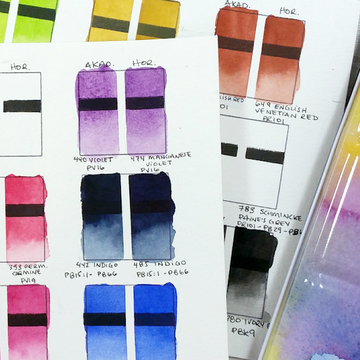Watercolour painting requires mainly these supplies: water, paper, paint and brush. The first one is quite easy to figure out, but the other three it can get quite confusing.
From personal experience, paint is the one thing that I’ve always been the most indecisive about. The watercolour paints section at the art supplies store is full of options.
Not only are there many brands, but there’s also two different grades of paints: student and professional. Both are presented in very favourable light by the companies’ marketing, so what’s the real difference between them?
The first and most obvious difference is the price. Student grade watercolours will always be less expensive than their professional equivalents.
That sounds really appealing at first, but there are many other differences between the two grades that you definitely want to take into consideration.
Student Grade
The lower price is not from the paint makers being generous towards students. To make the paints affordable to produce and to purchase, the companies will add other substances to the paint to extend and brighten the colour.
This lessens the value of the paint and also affects its behaviour.
A tube or pan of student grade paint will often be of a weaker strength than the professional version. It might also noticeably be less transparent because of the ingredients added to it.
Consequently, this can make painting very frustrating because some effects will simply be impossible to achieve with the student grade paint.
Layering them can build to a fuzzy final colour instead of a clean, deep one. They might not flow as smoothly either.
Some will dry poorly on the palette (they will crack and detach from the palette), which will make re-using them complicated.
When comparing different brands of student grade paints, it’s very difficult to reach a standard in the quality.
Some of them will be quite good, some others will be very difficult to use properly. It’s always a bit of a surprise when trying out a new student grade paint or set.
Not every company will make a student grade version of their paints. The ones that do, however, generally offer significantly less colours than those in their professional range.
The student range often contains a lot of hues, too.
Referring to a colour as a hue (“cadmium red hue” as an example) means that the colour is not made from a genuine cadmium pigment but rather another pigment, or combination of pigments, to reproduce the colour.
This often happens when a genuine pigment is too expensive, even with a student grade formula. You might not even be able to find a student version of certain colours.
Professional Grade

Many factors make professional paints something to consider, even when one is just beginning in watercolour.
I remember when I started painting with watercolours and used the most inexpensive paints the store would offer back then.
I enjoyed the process and would be so excited when I got a chance to paint something new. Eventually though, that interest faded.
The paints were weak, they didn’t mix all that well. Some colours were impossible to get through mixing. I couldn’t accomplish everything I wanted with the paints and moved on to some other medium.
It was only years later, when I bought a few professional grade tubes of paints on a whim, that I realised how everything I knew about watercolour was incomplete.
The professional paints were strong, bright, vivid.
They mixed well and created the most beautiful hues. I had struggled with my cheap paints so much, when in fact it would’ve been much less headache to switch to better quality paints.
In most cases, the professional grade paints are reliable, regardless of the brand. The discrepancies in performance are minimal and it becomes a matter of personal preference.
They tend to dry better in a palette and are easier to rewet and mix. With a professional version, you don’t get extenders and brighteners.
The basic formula for watercolours is water, gum arabic (to bind the pigment to the paper) and pigment.
There’s nothing to affect the colour. Some paints will use oxgall, to help with how a paint flows. Other brands will add honey to their formula, to make the paints easier to rewet and help preserve them.
Professional grade paints are not cutting corners to make themselves more affordable, which can be intimidating.
They sort their paints in series, usually, from the most affordable pigments to the most expensive ones.
The pricier pigments are more difficult to budget for, but there are always options in the lower price series, since professional paints feature a wider range of pigments available.

I also realise, in retrospect, that I would’ve been better served by having a primary triad of professional grade paints, rather than a student set of many more colours.
It’s a lot more work, having to mix everything, but that’s an excellent exercise in itself. It would’ve helped me develop my mixing abilities much earlier on. (More on colour mixing here!)
In my opinion, the grade of paints is the second most important thing to consider when buying watercolour supplies (after paper).
There are good student paints that will work very well on a nice cotton paper and there are awful student paints that no paper can save.
Student grade paints have their low price as an advantage, however their performance will depend on the brand.
Professional paints are more reliable, easier to use, come with many colour options and are more intense, but they can be very difficult to fit in a budget.
Ultimately, it’s about finding something that works for you and that you enjoy. I was no longer happy with my student paints, so I tried professional ones and never went back.
If, like me, you struggle with your student grade paints, maybe give professional paints a try!
What was your experience deciding which paints to buy? Let us know your thoughts in the comments!



